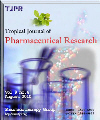
|
Tropical Journal of Pharmaceutical Research
Pharmacotherapy Group, Faculty of Pharmacy, University of Benin, Benin City, Nigeria
ISSN: 1596-5996
EISSN: 1596-5996
Vol. 13, No. 1, 2014, pp. 3-8
|
 Bioline Code: pr14001
Bioline Code: pr14001
Full paper language: English
Document type: Research Article
Document available free of charge
|
|
|
Tropical Journal of Pharmaceutical Research, Vol. 13, No. 1, 2014, pp. 3-8
| en |
Development and Optimization of Insulin-Chitosan Nanoparticles
Zhao, Liang; Su, Chang; Zhu, Bingya & Jia, Yunhong
Abstract
Purpose: To optimize the preparation of insulin-chitosan nanoparticles (ICNS) using response surface methodology (RSM).
Methods: ICNS were formulated through ionic cross linking method. The effects of the ratio between insulin and chitosan, pH of the medium and rotation speed on insulin encapsulation efficiency (EE) were investigated. Box-Behnken experimental design coupled with response surface method was employed to optimize formulation. Properties such as particle shape, size, zeta potential and release behavior were analyzed.
Results: The best formulation was produced under the following conditions: the ratio between insulin and chitosan was 0.08, pH 3.0, and rotation speed 187.4 rpm. Verifying experiments were established under the optimal conditions and EE was 93.1 %. Nanoparticles showed fine degree of sphericity and homogenous distribution of particle size. The particle size of nanoparticles was between 91.3 ± 7.9 and 220.2 ± 9.5 nm and the average zeta potential was 14.4 ± 2.9 mv. More than 16.8 % of total drug was released rapidly in the first 1 h. Thereafter, the insulin trapped in ICNS was released into the medium slowly and > 93.0 % was released completely within 24 h. Ritger-Peppas model was the best-fit drug release from all the formulations. The diffusion exponent (n) indicates that drug release pattern was non-Fickian diffusion.
Conclusion: Response surface method was a useful tool to predict the optimal formulation. ICNS showed excellent characteristics of homogenous particle size distribution, good spherical property, positive zeta potential and longer drug delivery. It could be a promising carrier for the oral administration of insulin.
Keywords
Nanoparticles; Response surface methodology; Insulim release; Encapsulation efficiency; Zeta potential; Ritger-Peppas model; Box-Behnken design
|
| |
© Copyright 2014 - Tropical Journal of Pharmaceutical Research
Alternative site location: http://www.tjpr.org
|
|
